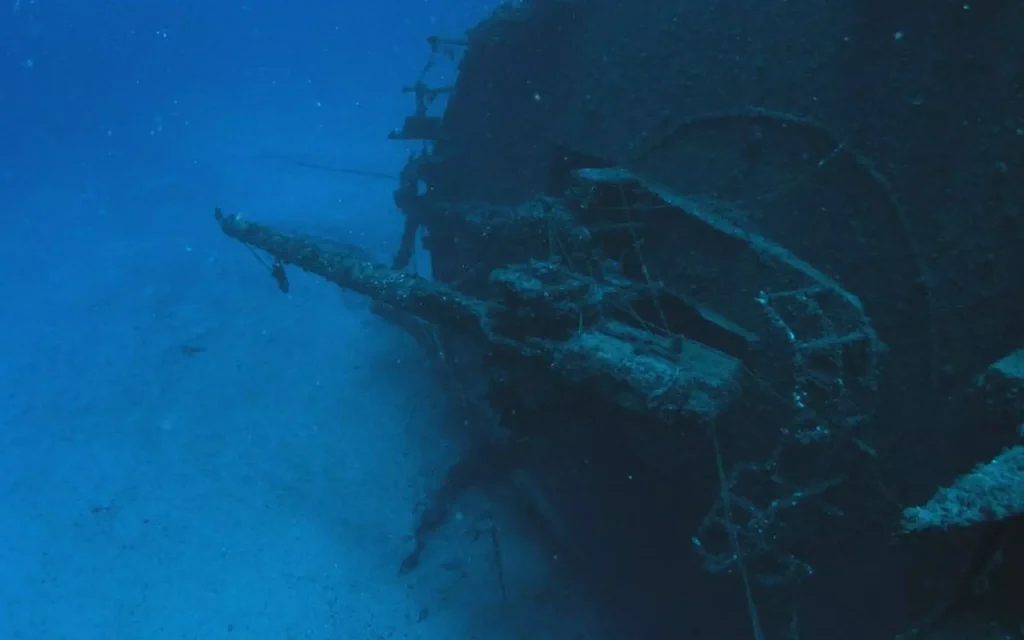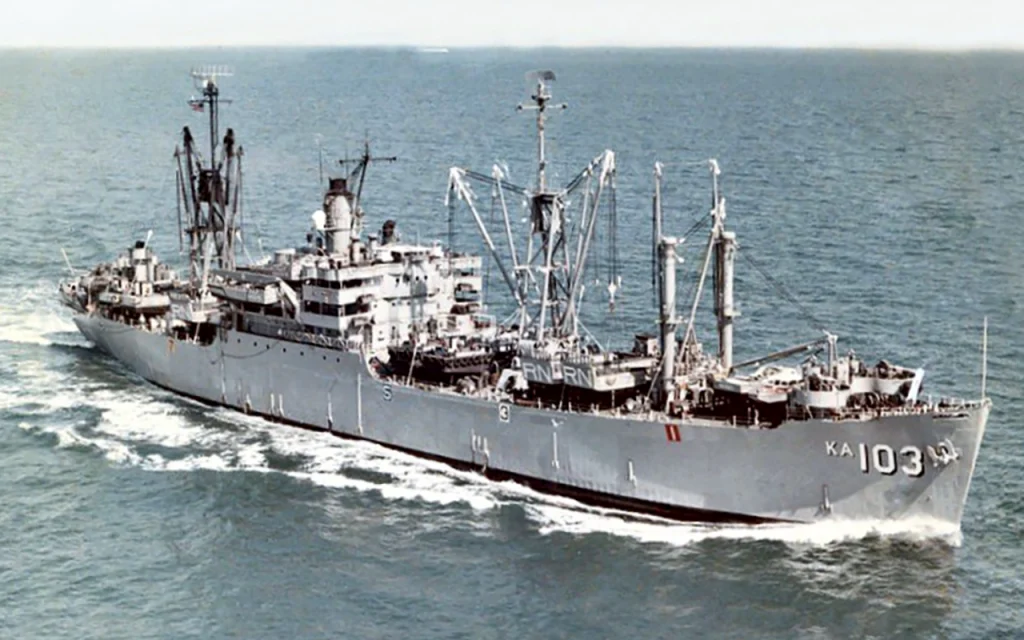Table of Contents

Article at a Glance
• Location: 6 miles east of Stuart, Florida
• Coordinates: 27°11.332’N, 80°01.431’W
• Depth: 130 feet (40 meters)
• Ship Type: Tolland-class attack cargo ship
• Length: 459 feet (140 meters)
• Sunk: July 24, 1988, as an artificial reef
• Notable Features: Rests on starboard side, home to diverse marine life including Goliath groupers
USS Rankin Wreck Location Coordinates and Depth
Depth
The USS Rankin rests at a maximum depth of about 130 feet(approximately 40 meters) on its starboard side.
Location
The wreck of the USS Rankin is located approximately six miles east of Stuart, Florida. The exact coordinates for the wreck are:
- Latitude: 27.18887° N
- Longitude: -80.02385° W
What to Scuba Divers Say About This Wreck
General Impressions
- Diving Experience: Many divers describe the USS Rankin as an exciting dive site due to its size and the marine life that inhabits the wreck. The ship’s dimensions (459 feet long) provide ample exploration opportunities, making it suitable for both experienced and novice divers.
- Visibility and Depth: Divers note that the visibility at the wreck can vary, but it generally offers a good view of the structure and surrounding marine environment. The wreck lies at a depth of about 130 feet, which some divers find challenging but rewarding.
Features of the Wreck
- Historical Significance: The USS Rankin is appreciated not only for its diving potential but also for its historical context as a former naval vessel. Divers often express interest in its history and the role it played during its service.
- Marine Life: The wreck has become an artificial reef, attracting a variety of marine life, which divers find fascinating. This biodiversity enhances the diving experience, providing opportunities for underwater photography and exploration.
Community Feedback
- Diver Reviews: On platforms like ScubaBoard, divers have shared their experiences, often praising the wreck’s condition and the thrill of exploring such a significant piece of maritime history. Comments about specific features, like the stern gun, highlight the wreck’s interesting artifacts.
What Kind of Marine Life Can Be Found on The Wreck
- Fish Species: Commonly spotted fish include:
- Black Sea Bass
- Amberjack
- Grouper
- Belted Sandfish
- Sunshine Fish
- Yellowtail Reef Fish
- Spottail Pinfish
- Purple Reef Fish
- Larger Marine Animals: Divers have occasionally seen larger species such as:
- Loggerhead Sea Turtles: Frequently observed, sometimes nesting in crevices of the wreck.
- Jewfish: Noted for their size and presence around the wreck.
- Southern Stingrays: Often found gliding over the sandy bottom near the wreck.
- Caribbean Reef Sharks: Occasionally spotted in the vicinity.
Key Information
| Attribute | Information |
|---|---|
| Name | USS Rankin |
| Type | Tolland-class attack cargo ship |
| Location | 6 miles east of Stuart, Florida |
| Coordinates | 27°11.332’N, 80°01.431’W |
| Depth | 130 feet (40 meters) |
| Length | 459 feet (140 meters) |
| Beam | 63 feet (19 meters) |
| Date Sunk | July 24, 1988 |
| Purpose | Artificial reef |
| Orientation | Rests on starboard side |
| Notable Marine Life | Goliath groupers, other reef fish |
| Visibility | Varies, can be excellent |
| Dive Difficulty | Advanced due to depth |
| Best Time to Dive | Year-round, summer for warmer water |
| Nearby City | Stuart, Florida |
What Makes USS Rankin a Unique Diving Experience
Historical Significanc
- World War II Legacy: The USS Rankin served in the Pacific Theater during World War II and was commissioned in 1944. Its historical context adds depth to the diving experience, allowing divers to connect with a significant piece of maritime history.
Size and Structure
- Large Wreck: At 459 feet long, the USS Rankin is one of the larger wrecks in the area. This size provides ample opportunities for exploration, with divers able to navigate various sections of the ship.
- Artificial Reef: Sunk in 1988 to create an artificial reef, the wreck has become a habitat for diverse marine life, enhancing the underwater ecosystem and making it an attractive site for both diving and marine observation.
Marine Life
- Biodiversity: The wreck attracts a variety of marine species, including Goliath grouper, sharks, and various reef fish. This rich biodiversity makes for an exciting and dynamic diving environment, with opportunities for underwater photography and observation.
Diving Conditions
- Depth and Visibility: The USS Rankin rests at approximately 130 feet, which is ideal for divers looking for a deeper dive with the potential for longer bottom times. Visibility can vary, but many divers report good conditions, allowing for clear views of the wreck and its surroundings.
Unique Dive Experience
- Less Commercialized: The Rankin is located in an area that is not heavily frequented by commercial dive operations, providing a more intimate and less crowded diving experience compared to more popular sites. This aspect contributes to a sense of adventure and exploration.
What is The Full History of This Wreck
Construction and Commissioning
- Laid Down: The USS Rankin was laid down on October 31, 1944, at the North Carolina Shipbuilding Company in Wilmington, North Carolina.
- Launched: It was launched on December 22, 1944, and commissioned on February 25, 1945.
World War II Service
- Pacific Fleet: In April 1945, the Rankin joined the Pacific Fleet and participated in significant operations, including the invasion of Okinawa in June 1945.
- End of War: While undergoing repairs in Seattle, Washington, Japan’s unconditional surrender marked the end of the ship’s wartime service.
Post-War and Recommissioning
- Reactivation: The Rankin was reactivated and assigned to the Atlantic Fleet, where it assisted in amphibious assault training operations.
- Beirut Landing: In 1958, it played a role in the landing of U.S. Marines in Beirut, Lebanon, during a period of political unrest.
- Reclassification: In 1969, the ship was reclassified from AKA-103 to LKA-103, reflecting its role as an amphibious cargo ship.
Later Years
- Decommissioning: The USS Rankin was decommissioned for the second time on May 11, 1971, and was stricken from the naval registry on January 1, 1977.
Sinking and Artificial Reef Creation
- Sunk as a Reef: On July 24, 1988, the USS Rankin was intentionally sunk approximately six miles off the coast of Stuart, Florida, to create an artificial reef. The wreck now rests on its starboard side at a depth of about 130 feet.
- Impact of Hurricanes: In 2004, hurricanes Frances and Jeanne caused significant damage to the wreck, breaking it in half and altering its structure. Despite this, the wreck remains an attractive habitat for marine life.

What Historical Features Can Still Be Identified on Wreck
- Ship Structure: The USS Rankin measures 459 feet in length and 63 feet in width. Its large size and recognizable shape make it an impressive sight underwater. The wreck rests on its starboard side, with sections of the hull and superstructure still visible.
- Armament Remnants: Identifiable remnants of the ship’s armament can still be seen, including:
- Gun Mounts: The canisters that once housed anti-aircraft guns are still present, indicating the ship’s military capabilities during its service.
- Five-Inch Gun: The ship was originally equipped with a five-inch gun, which may still be identifiable among the wreckage.
- Cargo Holds: The cargo holds, which were used to transport troops and supplies during its operational years, are still accessible. Divers can explore these areas, providing a glimpse into the ship’s function as an attack cargo vessel.
- Historical Artifacts: Various artifacts related to the ship’s service, such as remnants of equipment used during amphibious operations, can be found within the wreck. These items contribute to the historical narrative of the Rankin’s missions during World War II and the Korean War.
- Impact of Hurricanes: The wreck has been significantly altered by hurricanes, particularly Frances and Jeanne in 2004, which broke the ship in half. This damage has created new features and habitats for marine life, adding to the wreck’s uniqueness.
What Safety Measures Are in Place for Divers Visiting USS Rankin
Dive Operator Guidelines
- Certified Dive Operators: Divers are encouraged to use certified dive operators familiar with the USS Rankin site. These operators provide essential safety briefings and ensure that divers are equipped with the necessary gear for the conditions.
- Pre-Dive Briefing: Before the dive, operators typically conduct a thorough briefing that includes information about the wreck, potential hazards, and emergency procedures.
Equipment and Preparation
- Proper Gear: Divers must wear appropriate scuba gear, including a wetsuit or drysuit, depending on the water temperature, and carry sufficient safety equipment such as dive computers, tanks, and buoyancy control devices.
- Buddy System: Divers are advised to dive in pairs or groups to enhance safety, allowing for mutual assistance in case of emergencies.
Environmental Considerations
- Depth Awareness: The USS Rankin is located at approximately 130 feet, which requires divers to be aware of their depth limits and manage their air supply effectively to avoid decompression sickness.
- Visibility Conditions: Visibility can vary significantly in the area, so divers should be prepared for changing conditions. Operators often monitor weather and sea conditions to ensure safe diving.
Emergency Protocols
- Emergency Equipment: Divers should be familiar with the location of emergency equipment on the dive boat, including first aid kits and oxygen supplies.
- Communication: Establishing clear communication signals before the dive is crucial for safety, especially in case of equipment failure or other emergencies.
Post-Dive Procedures
- Decompression Stops: Depending on the dive profile, divers may need to perform decompression stops during their ascent to prevent decompression sickness.
- Post-Dive Monitoring: After the dive, divers should monitor themselves and their buddies for any signs of decompression sickness and seek medical attention if necessary.
Dive Shops That Prove Diving Trips to This Shipwreck
- Kirk’s Dive & Surf
- Rating: 4.9
- Address: 1991 NE Jensen Beach Blvd, Jensen Beach, FL 34957
- Website: Kirk’s Dive & Surf
- Stuart Scuba
- Rating: 4.7
- Address: 3317 SE Federal Hwy, Stuart, FL 34997
- Website: Stuart Scuba
- Force-E Scuba Centers – Riviera Beach
- Rating: 4.7
- Address: 155 Blue Heron Blvd, Riviera Beach, FL 33404
- Website: Force-E Scuba Centers – Riviera Beach
- Force-E Scuba Centers – Boca Raton
- Rating: 4.9
- Address: 2621 N Federal Hwy, Boca Raton, FL 33431
- Website: Force-E Scuba Centers – Boca Raton
- Force-E Scuba Centers – Boynton Beach
- Rating: 4.9
- Address: 270 N Congress Ave, Boynton Beach, FL 33426
- Website: Force-E Scuba Centers – Boynton Beach
- Jupiter Dive Center
- Rating: Not specified in the search results, but known for trips to the USS Rankin.
- Website: Jupiter Dive Center
Central Florida Wrecks
- SS Breconshire
- Georges Valentine
- Hog Heaven
- Urca De Lima
- USS Rankin
- Ana Cecilia
- United Caribbean
- USS Mindanao
- The Laertes
- Berry Patch Tug Wreck
- The Liberty Ship
- The Ana Cecilia
- The Cities Service Empire
- USS Accokeek
- The Tortuga Wreck
- Princess Ann Wreck (Palm Beach)
- Okinawa Wreck (Pompano Beach)
- MG-111 Wreck (Jupiter)
- Lady Luck Wreck (Pompano Beach)
- Rodeo 25 Wreck (Pompano Beach)
- Lowrance Wreck (Pompano Beach)
- RSB-1 Wreck (Deerfield Beach)
- Rebel Wreck (Deerfield Beach)
- Noulla Express Wreck (Fort Lauderdale)
- Sucre Wreck (Fort Lauderdale)
- Captain Tony Wreck (Pompano Beach)
- Peter McAllister Wreck (Pompano Beach)
- Guy Harvey Wreck (Fort Lauderdale)
- Quallman Tugs Wreck (Pompano Beach)
- Miller Lite Wreck (Pompano Beach)





